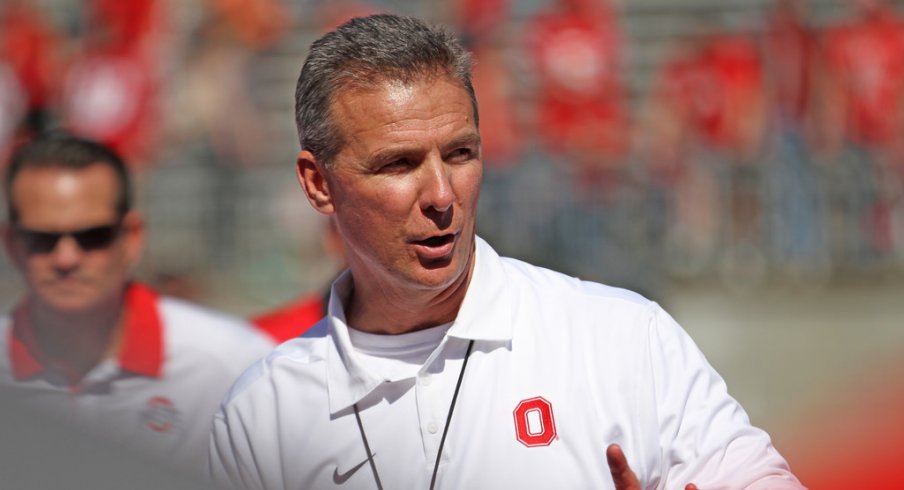With spring drills in the rearview mirror at Ohio State, Urban Meyer and his staff feel it necessary to inform each one of their players where they stand as the program turns its head toward the long haul of summer.
"Arguably, this is the most important offseason," Meyer said. "We just had a long staff meeting."
Ohio State's head coach and a group of assistants — Larry Johnson, Kerry Coombs, Zach Smith, Tim Beck, Greg Schiano, Tony Alford and Luke Fickell — halted their meetings with players in their position groups to speak to reporters at the Woody Hayes Athletic Center Wednesday. A young roster took steps forward during this spring's 15 practices, imperative with how much the program lost to the NFL after the 2015 season.
“It’s very, ‘Here it is.’ The worst thing you can do is have mixed messages sent to them.”– Urban Meyer on Player Evaluations
"Some guys really stepped up," Meyer said of Saturday's spring game, which the Gray bested the Scarlet, 28-17. "I thought Damon Arnette did really good. He’s got to play for us. Malik Hooker was a guy that was a no-name. Now, all of a sudden, he makes two interceptions in that game. Parris Campbell and Terry McLaurin did really well."
Expectations at Ohio State don't change even though more than half the roster is set to have freshman eligibility when training camp opens in August. That is why this week and the assessment of each player is so vital.
"It’s very, ‘Here it is.’ The worst thing you can do is have mixed messages sent to them," Meyer said. "That’s why we try to get the parents involved, too. That’s why we have a mandatory parents meeting Saturday at 9:30 a.m. If their kid is in the blue (category), get out of blue. That’s their job as a parent. We work together with them."
An individual one-on-one with the top dog of the program and then your child's position coach could be taken the wrong way by a parent of a former highly touted recruit, who Meyer may have even convinced to leave his home state for Columbus. But Meyer wants the parent-teacher conference to be a healthy conversation.
"Too often, people are like, ‘I’ll give you this kid, go handle it.’ No, no, no, that’s not how it works. We work together," Meyer said. "There are some great examples over the years of parents who have helped us. That’s why we try to be as transparent as possible.
“Some people don’t like that and can’t deal with being told, ‘Hey, you’re not very good. Here’s what you need to work on.’ That’s not our concern whether you like it or not."
If parents can't make the "mandatory" meeting Saturday, Meyer said they receive an email asking why. He wants them involved in their kid's future, because he's been on the other side of shirking his own daughters' events because of work.
"I don’t understand that. How do you miss a meeting when you are talking about your kid and his future and what’s going on?" Meyer said. "But people have family events, too. We weren’t able to go to all of my daughters’ events. But Shelley was pretty close. I like having fun with the parents, too."

What happens in these sit downs? Players rate themselves on a 1-5 scale, then Meyer does. Their position coach does too. Then, those numbers get added together.
"Then you add up the score and (it’s labeled) no bowl game or low-level bowl game or mid-level all the way up to national champion," Meyer said. "I change it a little bit each year, but it’s pretty accurate. If you’re between 90 and 100, that’s a player who is a college football playoff national championship-caliber player. Those are guys who handle their business academically, socially and athletically."
Competitive nature drives everything in a successful program, regardless the sport. It's why there are such things as winner-loser days at Ohio State.
And with such a young team seeping with untapped talent, an extra emphasis is on letting each guy know where he stands — even if it makes them a bit uneasy in your seat in the boss's office.
"What you try to do, I use video tape as a great teaching tool because you can show the good things and I never say the bad," defensive line coach Larry Johnson said. "The need to improve areas. Show them the video tape and then when they see it, understand the technique, they go 'wow.' The light comes on.
"Then you give them some personal goals," he continued, "each guy got a personal goal and what they can be expected to do and what their goals are going into the season."
Some get togethers last an hour. Others, maybe only 15 minutes. But it's time that has a track record of being well spent. Meyer mentioned past successes like Corey Linsley, Reid Fragel and most recently, future NFL wide receiver Michael Thomas.
"What great transitional stories of guys who were lost for three or four years and made their way back," Meyer said. "It’s because the parents dived knee-deep into it. Michael Thomas, there is no chance that happens without Keyshawn Johnson and his father. There were uncomfortable meetings, but they’re honest."


